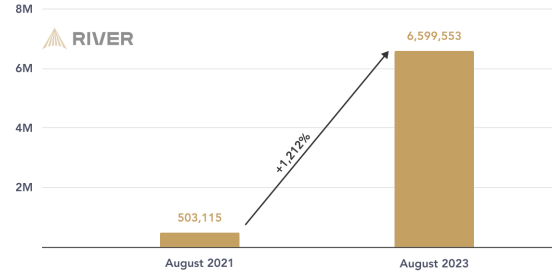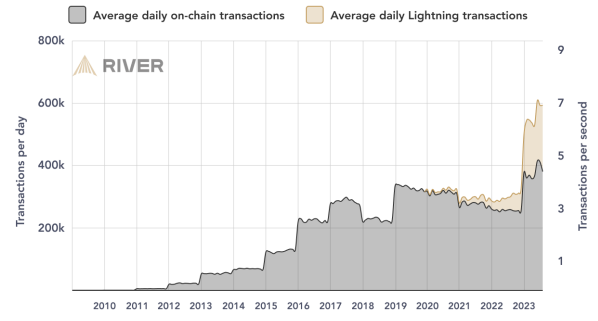
What is Bitcoin Lightning Network?
Lightning Network constitutes an infrastructure situated on a layer above the Bitcoin blockchain, known as layer 2. In this additional layer, which maintains the security of the main network, bidirectional payment channels are established between two parties. These channels enable instant transactions without the need for each one to be confirmed by the main network.
In essence, it is a network composed of bidirectional payment channels that facilitate fast and efficient transactions outside the main chain of the blockchain. It is important to note that transactions are not recorded directly on the blockchain until the payment channel is closed, contributing to alleviating network congestion and reducing transaction fees. In addition to its ability to expedite transactions and reduce fees, Lightning Network also stands out for its scalability.
By allowing numerous transactions to occur outside the main chain, scalability limitations faced by some blockchain networks are alleviated. This innovative approach facilitates the widespread adoption of Bitcoin and other cryptocurrencies by providing an efficient solution for micropayments and daily transactions. However, it is crucial to highlight that, despite its benefits, the implementation and widespread acceptance of Lightning Network also pose challenges and considerations, such as managing liquidity in channels and the security of the funds involved.
How does Bitcoin’s Lightning Network operate?
Bitcoin’s Lightning Network (LN) operates through bidirectional payment channels that function outside the main blockchain. This design allows for fast and cost-effective transactions between users. The sequence of operations begins with the opening of a channel, where two parties agree on terms and conditions through smart contracts. Both parties deposit a certain amount of Bitcoin into this contract to enable unrestricted transactions.
Once the channel is opened, parties can conduct private transactions outside the main chain, using signed agreements that reflect the channel’s balance and conditions. As transactions take place, the channel’s balance adjusts according to changes, such as cryptocurrency transfers between the parties. At any time, parties can close the channel, recording the latest version of the balance on the main Bitcoin chain and receiving the corresponding cryptocurrencies. The Lightning Network also enables payment routing through multiple connected channels, allowing transfers even between parties without a direct channel, enhancing network flexibility and connectivity.
The security of the Lightning Network is based on Hashed Time-Locked Contracts (HTLC), which establish conditions to validate transactions and prevent fraud. It is essential to emphasize that each transaction in the channel is not immediately reflected on the main Bitcoin chain, favoring greater scalability.
Final balances are recorded on the main chain only when closing the channel, maintaining the system’s integrity and security. Additionally, the LN payment channel functions as a smart contract made possible by Segregated Witness (SegWit). This smart contract is created as a secure Bitcoin transaction with multiple signatures, establishing specific conditions for its use. For example, it may include temporary locks to prevent traps and protect the involved parties. When the LN channel is closed, all settled transactions are sent to the main Bitcoin network as a single transaction, simplifying the load on the main chain and allowing more efficient scalability.
Advantages of Bitcoin’s Lightning Network

Improved Scalability:
Lightning Network addresses Bitcoin’s scalability challenge by facilitating a higher number of transactions per second. This enhances the overall efficiency of the network and enables faster transaction processing.
Reduced Transaction Costs:
By conducting transactions outside the main chain and not requiring confirmations for each transaction, the Lightning Network significantly reduces the costs associated with transactions. This makes it especially attractive for micropayments and lower-value transactions.
Enhanced Privacy:
Since transactions on the Lightning Network are not directly recorded on the main Bitcoin blockchain, privacy is improved. This aspect is beneficial for users seeking an additional layer of confidentiality in their transactions.
Instant Transactions:
The speed of the Lightning Network translates to the ability to make transactions almost instantly. This attribute is essential for applications and use cases that require immediate responses.
Considerably Lower Fees:
Thanks to avoiding congestions on the main chain, transaction fees on the Lightning Network are considerably lower. This makes it an efficient and cost-effective option for various transactions.
Scalability Capacity:
Lightning Network stands out for its ability to scale, meaning it can handle a higher volume of transactions as the network grows. This capacity is essential for the growth and mass adoption of the technology.
Energy Efficiency:
By reducing the number of transactions on the main chain, the Lightning Network contributes to greater energy efficiency in the blockchain ecosystem. This is achieved by requiring fewer computational resources to validate transactions outside the chain.
SegWit Interoperability:
Compatibility with Segregated Witness (SegWit) allows the Lightning Network to interoperate with various cryptocurrencies. This facilitates connection with different networks and digital currencies, promoting integration and collaboration between different projects.
Utility for Micropayments: The Lightning Network proves to be a particularly useful solution for micropayments and low-value transactions. Its ability to conduct numerous fast and economical transactions positions it as an effective tool in scenarios that demand payments of small amounts.
In summary, the Lightning Network offers a series of advantages that address key issues in the cryptocurrency ecosystem, improving efficiency, reducing costs, and facilitating new use cases.
Limitations and Challenges of Bitcoin’s Lightning Network

Limited Adoption:
Despite efforts to make the network more accessible, the number of active users and transactions on the Lightning Network still falls short of other networks. Limited adoption can affect the utility and expansion of the technology.
Technical Complexity:
The technical complexity of the Lightning Network can be a barrier to widespread adoption. The solution requires a minimum understanding of Bitcoin’s underlying technology, which could hinder its use for non-technical users. Although efforts are made to simplify its use, complexity persists.
Lack of Liquidity:
The lack of liquidity in Lightning Network payment channels can be a problem. Liquidity is essential to facilitate smooth transactions, and its absence can limit the effectiveness of the network.
Interoperability Issues: Limited interoperability or a lack of integration with certain standards can pose challenges. Lightning Network’s ability to collaborate efficiently with other platforms and systems can influence its success and overall utility.
Experimental Nature:
Despite being developed and tested, the Lightning Network remains an experimental technology. The possibility of unidentified security and scalability issues could limit its mass adoption, as users might be hesitant to adopt a technology with unknown risks.
Addressing these limitations and challenges is crucial to achieving broader and successful implementation of the Lightning Network in the cryptocurrency ecosystem.
Growth Over Time of the Lightning Network
Exponential Growth in Routed Transactions:

Between August 2021 and August 2023, routed transactions on the Lightning Network increased from 503,115 to 6,599,553. This growth represents an astonishing 1,212% increase. These routed transactions involve more than two nodes, suggesting increased activity on the network.
Volume of Transactions in US Dollars and Bitcoin:
The volume on the layer 2 protocol also experienced strong growth. In August 2021, the volume was $12.1 million and 303 BTC, and by August 2023, these numbers significantly increased to $78.8 million and 2,950 BTC. This represents a 546% increase in dollars and an impressive 874% increase in Bitcoin.
Resistance to General Bitcoin Trends:
Despite the overall decline in interest in Bitcoin, with a 45% decrease in Google searches and a 44% decrease in Bitcoin’s price, the Lightning Network has defied this trend. Achieving four-digit growth in the midst of adverse conditions is significant and suggests ongoing demand and adoption of the technology.
Positive Impact Despite the Bear Market: Despite having only 5,000 Bitcoin locked in the network and considering the current bear market, the Lightning Network has proven to be an effective solution and has achieved significant advancements. This underscores the utility and resilience of the network even in challenging market conditions.
This substantial growth in the number of transactions, transaction volume, and resistance to negative market trends suggests an increase in adoption and utility of the Lightning Network as a scaling solution for Bitcoin. It is important to note that these data reflect a specific trend until August 2023, as in recent months, the price of Bitcoin on the Lightning Network has shown significant fluctuations, ranging between 0.2209 and 0.3072.
This variation in value highlights the dynamic nature of the cryptocurrency market and reflects the influence of various factors, such as network demand, market events, and changes in economic conditions. Despite this volatility, the Lightning Network has continued its expansion, demonstrating its resilience and utility even in changing price environments.

Future of Bitcoin’s Lightning Network
Lightning Network emerges as a key solution to address scalability challenges in the Bitcoin ecosystem, aiming to position the cryptocurrency as an efficient and globally accessible means of payment. Although it faces limitations and challenges, its potential to transform the financial landscape is undeniable.
The evident improvements in speed, efficiency, and transaction privacy in Bitcoin, along with the significant reduction in transaction costs, support the promise of the Lightning Network as a revolutionary tool. Ongoing efforts to make the technology more accessible and user-friendly reflect the community’s commitment to increasing its adoption.
Ultimately, the Lightning Network not only represents an exciting evolution for Bitcoin but also an opportunity to explore new use cases and establish itself as a real alternative to the traditional financial system, without seeking to replace it entirely. As research and development continue, more applications are likely to emerge, and society is expected to increasingly embrace this innovative technology.
At Margex, we offer you the opportunity to trade Bitcoin and explore the exciting possibilities of the market. Our secure and user-friendly platform is the perfect place for those looking to leverage market volatility and enhance their trading strategies.
To stay updated on the latest trends, analysis, and news in the crypto world, we invite you to join our communities on Telegram, Discord, and Twitter.


